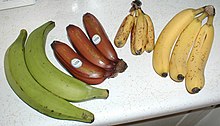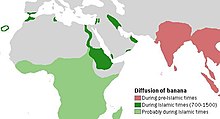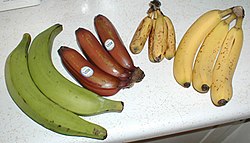For the plant genus to which bananas belong, see Musa (genus). For other uses, see Banana (disambiguation).
The banana is an edible fruit, botanically a berry,[1][2] produced by several kinds of large herbaceous flowering plants in thegenus Musa.[3] In some countries, bananas used for cooking may be called plantains. The fruit is variable in size, color and firmness, but is usually elongated and curved, with soft flesh rich in starch covered with a rind which may be green, yellow, red, purple, or brown when ripe. The fruits grow in clusters hanging from the top of the plant. Almost all modern edibleparthenocarpic (seedless) bananas come from two wild species – Musa acuminata and Musa balbisiana. The scientific names of most cultivated bananas are Musa acuminata, Musa balbisiana, and Musa × paradisiaca for the hybrid Musa acuminata × M. balbisiana, depending on their genomic constitution. The old scientific name Musa sapientum is no longer used.
Musa species are native to tropical Indomalaya and Australia, and are likely to have been first domesticated in Papua New Guinea.[4][5] They are grown in at least 107 countries,[6] primarily for their fruit, and to a lesser extent to make fiber, banana wine and banana beer and asornamental plants.
Worldwide, there is no sharp distinction between "bananas" and "plantains". Especially in the Americas and Europe, "banana" usually refers to soft, sweet, dessert bananas, particularly those of the Cavendish group, which are the main exports from banana-growing countries. By contrast, Musa cultivars with firmer, starchier fruit are called "plantains". In other regions, such as Southeast Asia, many more kinds of banana are grown and eaten, so the simple two-fold distinction is not useful and is not made in local languages.
The term "banana" is also used as the common name for the plants which produce the fruit.[3] This can extend to other members of the genus Musa like the scarlet banana (Musa coccinea), pink banana (Musa velutina) and the Fe'i bananas. It can also refer to members of the genus Ensete, like the snow banana (Ensete glaucum) and the economically important false banana (Ensete ventricosum). Both genera are classified under the banana family, Musaceae.
Description
The banana plant is the largest herbaceous flowering plant.[7] All the above-ground parts of a banana plant grow from a structure usually called a "corm".[8] Plants are normally tall and fairly sturdy, and are often mistaken for trees, but what appears to be a trunk is actually a "false stem" or pseudostem. Bananas grow in a wide variety of soils, as long as the soil is at least 60 cm deep, has good drainage and is not compacted.[9] The leaves of banana plants are composed of a "stalk" (petiole) and a blade (lamina). The base of the petiole widens to form a sheath; the tightly packed sheaths make up the pseudostem, which is all that supports the plant. The edges of the sheath meet when it is first produced, making it tubular. As new growth occurs in the centre of the pseudostem the edges are forced apart.[10] Cultivated banana plants vary in height depending on the variety and growing conditions. Most are around 5 m (16 ft) tall, with a range from 'Dwarf Cavendish' plants at around 3 m (10 ft) to 'Gros Michel' at 7 m (23 ft) or more.[11][12]Leaves are spirally arranged and may grow 2.7 metres (8.9 ft) long and 60 cm (2.0 ft) wide.[1] They are easily torn by the wind, resulting in the familiar frond look.[13]
When a banana plant is mature, the corm stops producing new leaves and begins to form a flower spike or inflorescence. A stem develops which grows up inside the pseudostem, carrying the immature inflorescence until eventually it emerges at the top.[14] Each pseudostem normally produces a single inflorescence, also known as the "banana heart". (More are sometimes produced; an exceptional plant in the Philippines produced five.[15]) After fruiting, the pseudostem dies, but offshoots will normally have developed from the base, so that the plant as a whole is perennial. In the plantation system of cultivation, only one of the offshoots will be allowed to develop in order to maintain spacing.[16] The inflorescence contains many bracts (sometimes incorrectly referred to as petals) between rows of flowers. The female flowers (which can develop into fruit) appear in rows further up the stem (closer to the leaves) from the rows of male flowers. The ovary is inferior, meaning that the tiny petals and other flower parts appear at the tip of the ovary.[17]
The banana fruits develop from the banana heart, in a large hanging cluster, made up of tiers (called "hands"), with up to 20 fruit to a tier. The hanging cluster is known as a bunch, comprising 3–20 tiers, or commercially as a "banana stem", and can weigh 30–50 kilograms (66–110 lb). Individual banana fruits (commonly known as a banana or "finger") average 125 grams (0.276 lb), of which approximately 75% is water and 25% dry matter (nutrient table, lower right).
The fruit has been described as a "leathery berry".[18] There is a protective outer layer (a peel or skin) with numerous long, thin strings (the phloem bundles), which run lengthwise between the skin and the edible inner portion. The inner part of the common yellow dessert variety can be split lengthwise into three sections that correspond to the inner portions of the three carpels by manually deforming the unopened fruit.[19] In cultivated varieties, the seeds are diminished nearly to non-existence; their remnants are tiny black specks in the interior of the fruit.[20]
Bananas are naturally slightly radioactive,[21][22] more so than most other fruits, because of their potassium content and the small amounts of the isotope potassium-40 found in naturally occurring potassium.[23] The banana equivalent dose of radiation is sometimes used in nuclear communication to compare radiation levels and exposures.[24]







